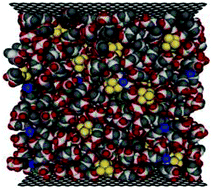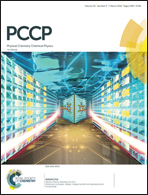The effect of different organic solvents on sodium ion storage in carbon nanopores†
Abstract
In this study fully atomistic grand canonical Monte Carlo (GCMC) simulations have been employed to study the behaviour of an electrolyte salt (NaPF6) and different non-aqueous (organic) solvents in carbon nanopores, to reveal the structure and storage mechanism. Organic solutions of Na+ and PF6− ions at 1 M concentration were considered, based on the conditions in operational sodium ion batteries and supercapacitors. Three organic solvents with different properties were selected: ethylene carbonate (EC), propylene carbonate (PC), and ethyl methyl carbonate (EMC). The effects of solvents, pore size and surface charge were quantified by calculating the radial distribution functions and ionic density profiles. It is shown that the organic solvent properties and nanopore confinement can affect the structure of the organic electrolyte solution. For the pore size range (1–5 nm) investigated in this paper, the surface charge used in this study can alter the sodium ions but not the solvent structure inside the pore.



 Please wait while we load your content...
Please wait while we load your content...